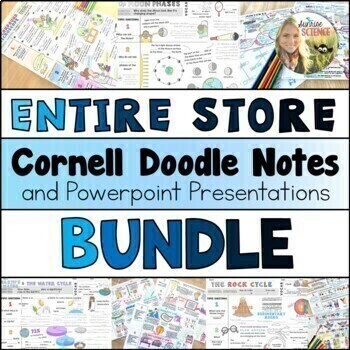Science Doodle Notes | Physical Life Earth Space | Middle School | Cornell Notes
- Zip
What educators are saying
Products in this Bundle (48)
showing 1-5 of 48 products
Description
This is a growing bundle of ALL of my Science Cornell Doodle Notes resources. This bundle currently contains Cornell Doodle Notes and the associated Powerpoint / Google Slides Presentations for 48 science topics. The price at this point reflects what is in the bundle at this time, plus 20% off. As an additional resource is added, the price of this bundle will rise accordingly.
✨GROWING! If you buy this bundle today, you are receiving 20% off on the current resources, plus you will receive all future Cornell Doodle Notes for free! You will receive notices under your My Purchases when a new resource is added to this bundle. If you Follow Me you will also receive an email from TPT when this bundle is updated.
Here are some things to know about Cornell Doodle Notes:
✓ A Powerpoint comes with each of these notes, and it is also available as a Google Slides presentation so that you can opt to share it with your students via Google Classroom
✓ Each set of notes also has a Sum It Up section or practice page to help students engage further with the information in the notes
✓ Each of the notes sets are scaffolded for two or three different levels (same content, different amounts of writing)
✓ Packed with visuals, examples, and analogies for brain-friendly learning
✓ No prep other than printing out the scaffolded note versions and sharing the Google link if necessary
✓ Easy to leave for a substitute
✓ Fun for students to color, which will help to aid retention of the content
✓ Supplements three-dimensional learning with rich content
✓ What Other Teachers are Saying:
"I absolutely love your doodle notes and how the illustrations help my students better understand the concepts. These were great and I will use year after year." (TeachingFUNdamentals)
"These have been a game changer for my students. They are so easy to understand and help my students grasp concepts they are struggling with." (Savanna E.)
"These doodle notes are fantastic and kids love them. I've used them for whole group instruction as well as students led notes in small groups. Totally recommend this resource!" (Rebecca W.)
"I adore these doodle notes. I use them all the time! My students love them too. They give a great review for my kiddos and a great resource for them to look back on to study from. Everything is organized beautifully as well. Love, love, love these. I own at least 5 different ones." (Melissa B.)
"The visuals and explanations are fantastic! I love how everything is so organized and appreciate the plethora of options that we get with this product. My 8th graders enjoyed the notes!" (Science Sparkles)
"My students love this resource. I've been trying out different types of doodle notes and these are perfect. There are different difficulty levels so I don't end up with dead space where half the class is finished and the other half is still trying to copy the work down. We will definitely be using them in the future!" (Bailey O.)
"These notes were so easy for my students to follow along with and they allowed them to gain a good understanding of the topic." (Jana K.)
"My students are loving these doodle notes--I SO appreciate the differentiation that's already done!" (Kelly B.)
✓ These are the topics currently in the bundle:
Metric System
Measuring Length, Volume, and Mass
Experimental Design & Scientific Method
Energy Forms and Transformations
Heat, Temperature, and Heat Transfer
Elements, Compounds, and Mixtures
The Atom
The Periodic Table
Bohr Diagrams
Valence Electrons
Phase Changes and Energy of Matter
Density
Boiling Point
Gas Laws and Behavior
Endothermic and Exothermic Processes
Ions and Ionic Bonding
Covalent Bonding
Balancing Chemical Equations
Chemical Reactions
Nuclear Fusion and Fission
Radioactive Decay
Mechanical Waves
Electromagnetic Waves and Spectrum
Speed and Velocity
Acceleration
Forces
Gravity and Weight
Newton's Laws of Motion
Layers of the Earth
Continental Drift & Seafloor Spreading
Plate Tectonics
Types of Rocks
Rock Cycle
Weathering
Erosion and Deposition
Relative Age Dating of Rocks
Water Cycle
Weather Variables
Weather Systems
Earth's Motion
Moon Phases
Seasons
Solar and Lunar Eclipses
Gravity and Orbiting
Compound Microscope
Cell Organelles
Photosynthesis
DNA Structure
Please note that these resources are not editable due to font and clip art licensing agreements. Also, if you plan to share this resource among a group of teachers, that's awesome! But, please purchase additional licenses!
Doodle notes is a trademarked term used with permission. Please visit doodlenotes.org for more information.
✨ You may also be interested in these Cornell Doodle Notes Bundles:
Physical Science Cornell Doodle Notes Bundle
Earth and Space Science Cornell Doodle Notes Bundle
Chemistry Topics Cornell Doodle Notes Bundle
Earth Science Cornell Doodle Notes Bundle
Thank you for looking!
Sunrise Science





